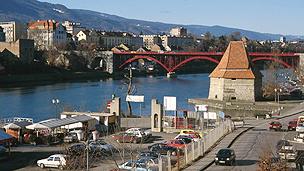Slovenia profile - Timeline
- Published
A chronology of key events:
1918 - After the collapse of the Austro-Hungarian empire, Slovenia joins the Kingdom of Serbs, Croats and Slovenes, later renamed Yugoslavia.
1941 - Slovenia is occupied by Nazi Germany and Italy during World War II.
1945 - Slovenia becomes a constituent republic of socialist Yugoslavia.
Independence
1990 - First multi-party elections. Milan Kucan becomes president. Overwhelming majority of Slovenes vote for independence in a referendum.
1991 - Slovenia, along with Croatia, declares its independence. The Yugoslav federal army intervenes. Slovene forces defend the country. The EU brokers a ceasefire and the Yugoslav army withdraws.
1992 - The EU and US recognise Slovenia's independence, and it joins the United Nations. First parliamentary and presidential elections in the newly independent country. Milan Kucan re-elected president. Janez Drnovsek becomes prime minister.
1996 - Slovenia signs an association agreement with the EU.
EU, Nato membership
1999 - Slovenia, a member of Nato's Partnership for Peace programme, allows Nato to use its airspace during the bombing of Kosovo and Serbia.
2002 December - Prime Minister Janez Drnovsek wins presidential elections.
EU summit in Copenhagen formally invites Slovenia to join in 2004.
2003 March - Referendum vote backs both EU and Nato membership.
2004 March - Slovenia admitted to Nato.
2004 May - Slovenia is one of 10 new states to join the EU.
2004 October - Centre-right Slovenian Democratic Party tops poll in general elections. Party leader Janez Jansa sets about forming coalition government.
2007 January - Slovenia becomes the first former communist state to adopt the single European currency, the euro.
2008 January - Slovenia becomes the first former communist state to assume the EU presidency.
Centre-left government

Maribor: Slovenia's second city was rebuilt after the Second World War
2008 November - Social Democratic leader Borut Pahor becomes prime minister at the head of a centre-left coalition comprising three other parties.
2011 September - PM Borut Pahor's centre-left coalition collapses after losing confidence vote in parliament. It remains in office as a caretaker government.
2012 February - Parliament approves new and mainly centre-right government led by Prime Minister Janez Jansa.
Anti-austerity protests
2012 November-December - Thousands of people take part in anti-austerity protests in Ljubljana and Slovenia's second city, Maribor.
2012 December - Centre-left former PM Borut Pahor wins presidential election at run-off vote, defeating incumbent Danilo Turk.
2013 March - The Jansa coalition collapses over disputes about austerity measures and corruption allegations. Liberal opposition leader Alenka Bratusek becomes prime minister.
2013 April - European Commission warns that urgent policy action is needed to tackle the problems of Slovenia's banks. Ratings agency Moody's cuts Slovenia's bonds to "junk" status, increasing likelihood that country will have to ask eurozone partners for bailout.
2013 May - Government unveils package of measures aimed at staving off EU bailout.
2013 November - Coalition government wins a confidence vote linked to the budget of 2014, signalling support for plans to rescue banks without recourse to an international bailout.
2014 August - Miro Cerar becomes prime minister after snap elections in July. His liberal SMC party agrees a coalition with two other centre-left parties.
2015 December - Voters in a referendum reject legislation that would have granted same-sex couples the right to marry.
2016 March - Slovenia says it will refuse transit to most migrants seeking to travel through the Balkan route to northern Europe.
Maritime dispute resolved
2017 June - An international court of arbitration hands Slovenia a victory in its maritime dispute with Croatia, ruling that it should have direct access to international waters in the Adriatic Sea using a corridor crossing Croatian waters.
2018 June - Snap elections see big wins for the SDS anti-immigration party of veteran former prime minister Janez Jansa, as well as for the relatively new centre-left LMS party.
2018 September - Marjan Sarec of the LMS is sworn in as head of a centre-left minority government, after the SDS fails to form a coalition.
2020 March - Janez Jansa returns as head of a centre-right coalition government after Marjan Sarec fails in a bid to call early elections.